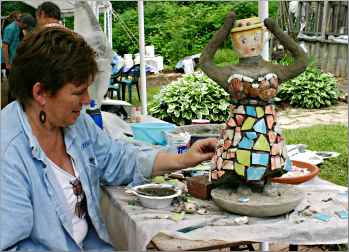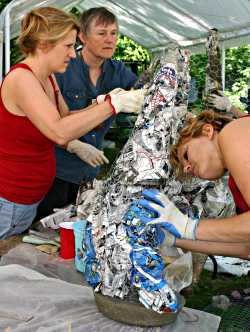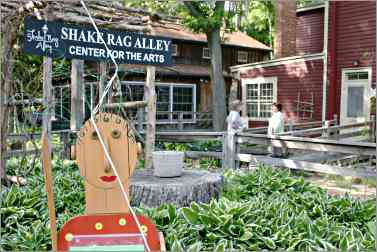Slinging cement in Mineral Point
In a historic Wisconsin village, students follow some dusty footprints.

© Beth Gauper
In southwest Wisconsin, it is natural that people gather in Mineral Point to smash plates, snip glass and cover themselves in cement dust.
Not far to the west, a German-born priest built the Dickeyville Grotto from conch shells, china cups, quartz, petrified rocks and glass.
Just to the east, an Austrian-born cheesemaker encrusted his house with glass "jewels" and filled his yard with concrete fairy-tale figures.
And in Mineral Point, the very air — faintly chalky from damp limestone — is thick with artistic impulses.
In the 1930s, an aesthete and an artist began restoring the town's lovely but crumbling Cornish cottages, and other artists followed them.
In the 1970s, a collection of nine miners' cottages and cabins, six of them no older than the 1840s, became home to artisans and antique dealers.
In 2004, it became Shake Rag Alley Center for Arts & Crafts, where anyone can become an artist.
At one popular workshop, students make the kinds of concrete sculptures for which Wisconsin roadsides are famous, plus garden stepping stones, bird baths and anything else they want to fashion out of concrete, mortar, pebbles, ceramics and glass.
One year, I signed up for it.
"Don't be intimidated; no one here really knows what they're doing," Paula O'Kray of Stevens Point, Wis., told me when I arrived late.
O'Kray was making a concrete peacock, using curled telephone wire for feathers. That was instructor Judy Sutcliffe's idea. She had many good ideas, also suggesting that Tonie Rocke of Mount Horeb, Wis., use the broken china cup she'd brought not in the mosaic but as the head of her garden lady, with trailing vines for hair.

© Beth Gauper
Working under tents beside a burbling spring, we first made armatures by sinking steel rods into plastic bowls filled with wet concrete. While that set, we made bird baths by draping a giant rhubarb leaf over a mound of wet sand, then covering it with concrete.
Some people made garden stepping stones, lining the bottom of small pizza boxes with leaves, then filling them with concrete.
That was easy compared with our sculptures. For those, the next step was molding chicken wire around balled-up newspaper and foam balls and attaching it to the steel rods. We covered our armatures with two layers of concrete, then used mortar to attach a mosaic chosen from bins full of broken crockery, tiles, glass and mirrors.
Some people brought their own gewgaws; everyone admired Nancy Welch for her forks with curled tines, which she embedded into a heart sculpture. Welch, of Madison, was one of several art teachers taking the workshop.
"I always say that at this time of year I don't have any ideas left, because I've given them all away," said Deb Hyland, an art teacher in Galena, Ill. "I never have any time to do anything for myself."
But that left the rest of us wondering if our creativity would measure up.
"I was really apprehensive about doing this, it's so far out of my comfort zone," said Carolyn Iwanski of Stevens Point, Wis., who made a bird house. "I'm not the artistic type."
I felt the pressure, too, and it made me briefly lose sight of why I love "outsider" art: It's unstudied, imperfect and exuberantly original.
So when I complained that the glass pieces I was cutting were "irregular," Sutcliffe burst out laughing, and instructor Heidi Dyas-McBeth gave me a strange look.
"Irregular is good," she reminded me.
It was Sutcliffe and Longbranch Gallery partner Sandy Scott who spearheaded the drive to buy Shake Rag Alley, which they had been using for their annual Woodlanders Gathering of rustic-furniture makers.
All of their workshops are hands-on; for the concrete/mosaic class, Sutcliffe and Dyas-McBeth mostly circulated among the students, answering questions and offering advice.
"This is so encouraging, so supportive and so unlike the real world, you don't want to leave," said O'Kray, who had attended the Woodlanders weekend and planned to return.
I didn't want to leave, either. Mineral Point not only is beautiful — it was the first city in Wisconsin to be listed on the National Register of Historic Places — but it has to be the friendliest place in the Upper Midwest.
Everywhere I went, townspeople said hello and asked how I was; as I listened to the free Friday-evening concert at the Orchard Lawn mansion, the president of the historical society came over to welcome me and introduce himself.

© Beth Gauper
People get involved in this town of 2,600; after all, it raised $100,000 toward the purchase of Shake Rag Alley in just six weeks, saving it from becoming a private vacation retreat.
In other towns, Shake Rag Alley would have become a trophy home for a tycoon, and it came close. But Mineral Point isn't just any town, and residents want to keep it that way.
"A lot of people have very loving feelings for this property," Sandy Scott says. "There's been a lot of history passing through here."
For more about the town, see Beauty in Mineral Point.
For more about Nick Engelbert's Grandview in nearby Hollandale and other Wisconsin sculpture environments, see Magnificent obsessions.
Trip Tips: Shake Rag Alley Center for the Arts
Getting there: Mineral Point is 45 minutes west of Madison, five hours from the Twin Cities and 3½ hours from Chicago.
Multi-day summer workshops: They include the Woodlanders Gathering in July.
Many one- and two-day workshops are offered in writing and rustic and fine arts year-round.
Annual events: There's a Tour of Fairy Homes in May and Garden Tour in June.
Lodging: The center rents three small but very comfortable rooms in its 1840s Coach House onsite and two apartments in a building on Commerce Street. Guests who are taking classes get a 10 percent discount.
Nightlife: The Alley Stage, an amphitheater built into the rocky hillside, puts on plays and other events.
Information: Shake Rag Alley, 608-987-3292.